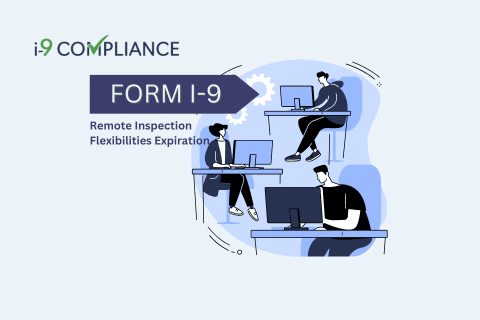DHS Announces 30-Day Grace Period After Expiration of Form I-9 Remote Inspection Flexibilities

May 11, 2023
The U.S. Department of Homeland Security (DHS) and Immigrations and Customs Enforcement (ICE) have reaffirmed the end of the Form I-9 remote flexibilities. According to the announcement, employers must perform in-person inspections and correct remotely completed forms by August 30, 2023. As such, many employers should begin arranging physical meetings and taking the necessary steps to correct forms completed using the remote flexibilities provided early in the pandemic.
This announcement concerns the DHS’s March 2020 guidance that addressed pandemic-related concerns. This guidance allowed employers operating remotely due to pandemic-related precautions to complete the Form I-9 remotely. As a result, employers collected and reviewed identity and work authorization documentation required to complete the employment eligibility verification process.
Before the USCIS implemented the temporary flexibility, employers inspected this documentation physically. However, the temporary guidance allowed employers to defer the inspection and use virtual means to verify documentation. For example, employers could use video calls, email, or fax to verify the information. The timeline for completing this process included the same three days after an employee’s first date of employment. Employers would enter COVID-19 into the additional information field to explain the delay.
After many extensions to this policy, such as the most recent in October 2022, it will finally expire on July 31, 2023. Now, employers will have a 30-day grace period after the expiration of this policy to inspect and verify the documentation physically. This period includes making corrections as needed.
Due to this, employers should begin planning to identify any remotely completed Form I-9s and inform affected parties to prepare to submit their employment authorization and identification documents. In addition, employers may find that many employees have expired or lost their original documentation. As a result, they may need to present new and current documents.
Unfortunately, should employees choose to provide other documentation, they may find that the information does not fit the existing documents. In this case, the employer or their representative may attach a new Section 2 or 3 to the current form. After physically examining an employee’s documentation, the employer or their authorized representative should add “documents physically examined” and the inspection date into the additional information field of Section 2 or 3, as appropriate.
One of the best ways to remain organized amongst these changes and avoid making costly mistakes is to use an electronic I-9 management tool. This tool can guide HR personnel through the I-9 process and ensure uniform and correct completion of every form.
Ensure compliance today by switching to an electronic I-9 management tool with I-9Compliance.